Journal Description
Société Internationale d’Urologie Journal
Société Internationale d’Urologie Journal
(SIUJ) is an international, peer-reviewed, open access journal that covers all aspects of urology and related fields. The journal is owned by the Société Internationale d’Urologie (SIU) and is published bimonthly online by MDPI (since Volume 5, Issue 1 - 2024).
- Open Access— free for readers and authors (diamond open access), with article processing charges (APC) paid by the Société Internationale d’Urologie.
- Rapid Publication: manuscripts are peer-reviewed and a first decision is provided to authors approximately 56.3 days after submission; acceptance to publication is undertaken in 21.1 days (median values for papers published in this journal in the second half of 2024).
- Recognition of Reviewers: APC discount vouchers, optional signed peer review, and reviewer names published annually in the journal.
subject
Imprint Information
Open Access
ISSN: 2563-6499
Latest Articles
SIU-ICUD: Localized Prostate Cancer: Pathological Factors That Influence Outcomes and Management
Soc. Int. Urol. J. 2025, 6(3), 41; https://doi.org/10.3390/siuj6030041 - 7 Jun 2025
Abstract
►
Show Figures
Background/Objectives: Pathological factors are integral in the risk stratification and management of localized prostate cancer. In recent years, there has been an upsurge of studies that uncovered novel approaches and have refined prognostic factors for prostate cancer in needle biopsy and radical prostatectomy
[...] Read more.
Background/Objectives: Pathological factors are integral in the risk stratification and management of localized prostate cancer. In recent years, there has been an upsurge of studies that uncovered novel approaches and have refined prognostic factors for prostate cancer in needle biopsy and radical prostatectomy (RP) specimens. Methods: We conducted a review of literature and summarized the significant recent updates on pathological factors for localized prostate cancer. Results: Innovative factors derived from the traditional Gleason grading, such as the extent of Gleason pattern 4 and presence of cribriform pattern are now recognized to significantly improve discrimination of outcome. The components and rules of Gleason grading themselves underwent modifications, and the subsequent prognostic grouping of the different grades (Grade group) have resulted in enhanced stratification of behavior more meaningful in management decision. The approaches for grade reporting in systematic or targeted needle biopsies and in RP with multifocal cancers are also being optimized. Newer tumor growth pattern-based factors such as intraductal carcinoma and atypical intraductal proliferation can have ramifications in management, especially in the background of low to intermediate risk prostate cancers. Gleason grade considerations in the different post-treatment settings and for de novo and residual prostate cancers with varying treatment effects have also been explicated. Likewise, the application of more traditional factors in tumor extent and perineural invasion in biopsy, or positive surgical margin in RP, have also evolved. Conclusions: Some of these newer pathological factors are now officially recommended in standardized pathology reporting protocols and are applied in the management decision for localized prostate cancer.
Full article
Open AccessReview
SIU-ICUD Prevention of Lethal Prostate Cancer via Modifiable Heart-Healthy Lifestyle Changes, Metrics, and Repurposed Medications
by
Mark A. Moyad, Raj V. Tiwari, Daniel A. Galvão, Dennis R. Taaffe and Robert U. Newton
Soc. Int. Urol. J. 2025, 6(3), 40; https://doi.org/10.3390/siuj6030040 - 7 Jun 2025
Abstract
Background/Objectives: Primary prevention, germline, familial, or other pre- or post-diagnostic and standard treatment-elevated progression or recurrence risk and mitigating adverse events from systemic treatment are all clinical opportunities to reduce the risk of lethal prostate cancer. This review attempted to provide a
[...] Read more.
Background/Objectives: Primary prevention, germline, familial, or other pre- or post-diagnostic and standard treatment-elevated progression or recurrence risk and mitigating adverse events from systemic treatment are all clinical opportunities to reduce the risk of lethal prostate cancer. This review attempted to provide a practical and realistic consensus via an international committee of experts who, in general, harbor career-long experience in this discipline. Methods: A PubMed review primarily utilizing the latest meta-analyses, systematic reviews, and methodologically robust epidemiologic recent data adjusting for multiple confounding variables was conducted. The goal of this committee was to highlight tangible options for clinicians and patients. Results: Behavioral patterns and metrics known to reduce cardiovascular morbidity, mortality, and all-cause mortality (premature death) appear to prevent numerous lethal common cancers, including prostate cancer. This practical approach allows for the greatest probability of patient success since cardiovascular disease (CVD) is the primary cause of death in men with and without prostate cancer, and a notable source of morbidity and mortality in men with advanced disease due to systemic conventional treatment as well as the inflammatory contribution of cancer itself. Heart-healthy dietary patterns, exercise, healthy weight/waist circumference, eliminating tobacco, minimizing alcohol exposure, and other behaviors to reduce the risk of CVD should be prioritized. CVD-preventive medications, including aspirin, GLP-1 agonists, metformin, statins, etc., should receive attention to improve compliance for those that already qualify for these agents and to increase the probability of enhancing the quality and quantity of life. Dietary supplements do not have favorable data currently to espouse their utilization to prevent lethal prostate cancer but may have an ancillary role in mitigating some adverse effects of treatment. Conclusions: Remarkably, heart-healthy lifestyle changes, metrics, and promising repurposed medications known to reduce cardiovascular events, promote longevity, and improve mental health could simultaneously prevent lethal prostate cancer. This serendipitous association provides clinicians and their patients a higher probability of success, regardless of their prostate cancer pathway or circumstance.
Full article
Open AccessReview
SIU-ICUD Comprehensive Imaging in Prostate Cancer: A Focus on MRI and Micro-Ultrasound
by
Cesare Saitta, Wayne G. Brisbane, Hannes Cash, Sangeet Ghai, Francesco Giganti, Adam Kinnaird, Daniel Margolis and Giovanni Lughezzani
Soc. Int. Urol. J. 2025, 6(3), 39; https://doi.org/10.3390/siuj6030039 - 7 Jun 2025
Abstract
►▼
Show Figures
Background/Objectives: The diagnostic approach to prostate cancer (PCa) has evolved from systematic biopsies to imaging-guided strategies that improve detection of clinically significant PCa (csPCa) while reducing overdiagnosis. Multiparametric magnetic resonance imaging (mpMRI) has emerged as the gold standard for pre-biopsy evaluation, while micro-ultrasound
[...] Read more.
Background/Objectives: The diagnostic approach to prostate cancer (PCa) has evolved from systematic biopsies to imaging-guided strategies that improve detection of clinically significant PCa (csPCa) while reducing overdiagnosis. Multiparametric magnetic resonance imaging (mpMRI) has emerged as the gold standard for pre-biopsy evaluation, while micro-ultrasound (MicroUS) offers a promising alternative with real-time imaging capabilities. Methods: We examined the principles, image interpretation frameworks (Prostate Imaging Reporting and Data System (PI-RADS) and Prostate Risk Identification using Micro UltraSound (PRI-MUS)), and clinical applications of mpMRI and MicroUS, comparing their diagnostic accuracy in biopsy-naïve patients, repeat biopsy scenarios, active surveillance, and staging. Results: mpMRI improves csPCa detection, reduces unnecessary biopsies, and enhances risk stratification. Landmark studies such as PRECISION (Prostate Evaluation for Clinically Important Disease: Sampling Using Image Guidance or Not?) and PRIME (Prostate Imaging Using MRI±Contrast Enhancement) confirm its superiority over systematic biopsy. However, mpMRI remains resource-intensive, with limitations in accessibility and interpretation variability. Conversely, MicroUS, with its high-resolution real-time imaging, shows non-inferiority to mpMRI and potential advantages in magnetic resonance imaging (MRI)-ineligible patients. It improves lesion visualization and biopsy targeting, with ongoing trials such as OPTIMUM (Optimization of prostate biopsy—Micro-Ultrasound versus MRI) evaluating its standalone efficacy. Conclusions: mpMRI and MicroUS are complementary modalities in PCa diagnosis. While mpMRI remains the preferred imaging standard, MicroUS offers an alternative, particularly in patients with MRI contraindications. Combining these techniques could enhance diagnostic accuracy, reduce unnecessary interventions, and refine active surveillance strategies. Future research should focus on integrating both modalities into standardized diagnostic pathways for a more individualized approach.
Full article

Figure 1
Open AccessReview
SIU-ICUD Focal Therapy for PCa: The Technique
by
Lara Rodriguez-Sanchez, Thomas J. Polascik, Kara Watts, Peter Ka-Fung Chiu, Mark Emberton, Behfar Ehdaie, Hashim U. Ahmed, Andre Abreu, Ardeshir R. Rastinehad and Rafael Sanchez-Salas
Soc. Int. Urol. J. 2025, 6(3), 38; https://doi.org/10.3390/siuj6030038 - 7 Jun 2025
Abstract
►▼
Show Figures
Background/Objectives: Focal therapy (FT) and technology are closely connected. Advanced imaging allows for precise identification of the index lesion, enabling the targeted use of various thermal and non-thermal energy sources through different approaches, with specific techniques tailored to lesion location and operator expertise.
[...] Read more.
Background/Objectives: Focal therapy (FT) and technology are closely connected. Advanced imaging allows for precise identification of the index lesion, enabling the targeted use of various thermal and non-thermal energy sources through different approaches, with specific techniques tailored to lesion location and operator expertise. This personalized approach enhances both safety and effectiveness, facilitating customized treatment planning. Methods: The International Consultation on Urological Diseases formed a committee to review the current literature on FT for prostate cancer (PCa), focusing specifically on the technique. Following in-depth discussions, the committee chose a “by lesion” approach rather than the traditional “by energy” approach to structure the review. A comprehensive PubMed search was conducted to gather relevant articles on the various energy modalities and procedural approaches used in FT for PCa. Results: Lesions in the apex, anterior, and posterior regions of the prostate can be accessed through several FT approaches, each associated with specific energy modalities and techniques. The transrectal approach utilizes high-intensity focused ultrasound (HIFU) and focal laser ablation (FLA), while the transperineal approach is compatible with energy sources such as cryotherapy, irreversible electroporation (IRE), brachytherapy, and FLA. The transurethral approach supports methods such as transurethral ultrasound ablation (TULSA). Each approach offers distinct advantages based on lesion location, treatment area, and energy modality. The choice of technique evaluated the safety and efficacy of each energy source and approach based on specific treatment areas within the prostate, highlighting the need for robust research across lesion locations and modalities, rather than focusing solely on each modality for a specific region. Conclusions: FT is rapidly advancing with new energy sources, technological improvements, and increasing operator expertise. To further optimize FT, research should prioritize evaluating the safety and effectiveness of different energy sources for various lesion locations, focusing on the treatment area rather than the energy modality itself.
Full article

Figure 1
Open AccessSystematic Review
SIU-ICUD Extended vs. Standard Pelvic Lymph Node Dissection in Bladder Cancer Patients Undergoing Radical Cystectomy: Systematic Review and Meta-Analysis
by
Jordan Santucci, Peter Stapleton, Marlon Perera, Nathan Lawrentschuk, Declan Murphy and Niranjan Sathianathen
Soc. Int. Urol. J. 2025, 6(3), 37; https://doi.org/10.3390/siuj6030037 - 7 Jun 2025
Abstract
►▼
Show Figures
Background/Objectives: Pelvic lymph node dissection during radical cystectomy has been established to be important for staging and therapeutic purposes. However, there is uncertainty regarding the optimal extent of nodal dissection. This study aimed to assess the impact of an extended pelvic lymphadenectomy template
[...] Read more.
Background/Objectives: Pelvic lymph node dissection during radical cystectomy has been established to be important for staging and therapeutic purposes. However, there is uncertainty regarding the optimal extent of nodal dissection. This study aimed to assess the impact of an extended pelvic lymphadenectomy template compared to a standard template in patients with bladder cancer undergoing radical cystectomy. Methods: We performed a systematic review and meta-analysis of randomised studies comparing extended pelvic lymph node dissection to standard pelvic lymph node dissection in patients undergoing radical cystectomy. A search of multiple databases was performed up to October 2024. The standard template was defined as including at least the obturator and internal and external iliac nodes. An extended template was defined as a standard template plus the removal of proximal nodal packets. The primary outcomes were overall survival and major Clavien–Dindo complications. Results: Two studies encompassing a total of 933 participants met the eligibility criteria. There was no observed improvement in overall survival with extended lymph node dissection compared to limited dissection [HR 0.95, 95%CI 0.66–1.4]. In addition, extended lymph node dissection was associated with an increased risk of grade ≥3 Clavien–Dindo complications compared to limited nodal dissection [RR 1.2, 95%CI 1.02–1.37]. There was also an increased risk of lymphoceles requiring intervention with extended lymphadenectomy. Conclusions: Extended pelvic lymphadenectomy does not improve oncological outcomes and is associated with increased morbidity compared to a standard template in bladder cancer patients undergoing radical cystectomy.
Full article

Figure 1
Open AccessReview
SIU-ICUD on Screening and Early Detection of Prostate Cancer
by
Ola Bratt, Mohamed Jalloh, Anwar R. Padhani, Paul F. Pinsky, Hein Van Poppel, Weranja Ranasinghe, Kamran Zargar-Shoshtari, Kai Zhang and Anssi Auvinen
Soc. Int. Urol. J. 2025, 6(3), 36; https://doi.org/10.3390/siuj6030036 - 4 Jun 2025
Abstract
►▼
Show Figures
Background/Objectives: Randomised trials show that screening with prostate-specific antigen (PSA) and systematic prostate biopsies can reduce prostate cancer mortality but leads to high rates of overdiagnosis. Today, improved diagnostic methods more selectively detect potentially lethal, high-grade prostate cancer. Methods: This is a narrative
[...] Read more.
Background/Objectives: Randomised trials show that screening with prostate-specific antigen (PSA) and systematic prostate biopsies can reduce prostate cancer mortality but leads to high rates of overdiagnosis. Today, improved diagnostic methods more selectively detect potentially lethal, high-grade prostate cancer. Methods: This is a narrative review of modern diagnostic methods, ongoing trials, national policies and knowledge gaps related to screening and early detection of prostate cancer. Results: Screening intervals can be prolonged in men with PSA values below around 1 ng/mL as these men are at very low long-term risk of prostate cancer death. Overdiagnosis can be reduced by magnetic resonance imaging (MRI) and lesion-targeted prostate biopsies. Risk calculators and ancillary biomarkers can select men for further investigation and thereby reduce resource needs. These new methods are evaluated in large, randomised screening trials. The remaining knowledge gaps include optimal PSA cut-offs, screening intervals, start and stop ages, and the long-term balance between benefits and harm. Until recently, almost no national healthcare authority recommended population-based screening for prostate cancer. Now, the European Union Council recommends an evaluation of the feasibility of organised, risk-stratified screening. This has led to several pilot projects. In some other parts of the world, such as sub-Saharan Africa and the Caribbean, such initiatives are lacking despite high prostate cancer mortality rates. Conclusions: Risk-stratified prostate cancer screening including MRI and targeted biopsy reduces overdiagnosis. Results from ongoing research are needed to optimise screening protocols and to define long-term benefits and harms. Initiatives for early detection and screening are emerging across the world but are still lacking in many countries with high prostate cancer mortality.
Full article

Figure 1
Open AccessArticle
A 5-Year Follow-Up of Patient-Reported Outcome Measures Following External Beam Radiotherapy or Radical Prostatectomy in Localised Prostate Cancer
by
Rowan V. David, Peter L. Stapleton, Arman A. Kahokehr, Jason Lee, David I. Watson, John Leung and Michael E. O’Callaghan
Soc. Int. Urol. J. 2025, 6(2), 35; https://doi.org/10.3390/siuj6020035 - 21 Apr 2025
Abstract
►▼
Show Figures
Background/Objectives: Late toxicity following radiotherapy is common and compromises patient quality of life. However, the impact of toxicity on patient-reported outcome measures (PROMs) five years after prostate external beam radiotherapy (EBRT) is poorly characterised. We describe PROMs using the Expanded Prostate Cancer
[...] Read more.
Background/Objectives: Late toxicity following radiotherapy is common and compromises patient quality of life. However, the impact of toxicity on patient-reported outcome measures (PROMs) five years after prostate external beam radiotherapy (EBRT) is poorly characterised. We describe PROMs using the Expanded Prostate Cancer Index Composite (EPIC-26) five years post-EBRT compared against radical prostatectomy (RP). Methods: A prospective cohort of patients with localised prostate cancer treated from 2000 to 2020 captured by a state-level cancer registry was analysed. Multivariable mixed-effects linear modelling was performed to compare differences between EPIC-26 domains over time between ERBT and RP patients. The percentage of patients recording a decline in EPIC-26 domains compared with baseline which exceeded the minimal clinically important difference (MCID) was calculated and compared between groups. Additionally, subgroup analysis was performed on patients treated using contemporary techniques. Results: There were 1720 patients (EBRT n = 1441 vs. RP n = 279) with evaluable EPIC-26 PROMS. Patients in the EBRT group had a higher median age (74 vs. 66, p < 0.001) and National comprehensive Cancer Network (NCCN) high-risk disease (61% vs. 24%, p < 0.001). Bowel domain scores were worse after EBRT compared to RP (beta −0.46, 95% CI −1.20–−0.28, p < 0.001), with a greater proportion of patients reporting a change in symptoms that exceeded the MICD at 12 months (22 vs. 11%, p = 0.009). Moderate/big bowel bother scores were significantly higher in the EBRT cohort at baseline and all follow-up periods compared to RP (beta −8.27, 95% CI −10.21–−6.34, p < 0.001). Pad use (i.e., ≥1) per day was significantly lower amongst the EBRT group (beta 16.56, 95% CI 14.35–18.76, p < 0.001). Despite contemporary techniques, EBRT was associated with worse bowel domain scores at 12 (75 vs. 80, p < 0.05) and 60 months (75 vs. 80, p < 0.05) compared to RP; however, EBRT was associated with less pad use at 12 (4% vs. 34%, p < 0.001), 24 (10% vs. 33%, p < 0.001) and 60 months (13% vs. 33%, p = 0.15) than RP. Conclusions: There are significant differences in PROMs after local curative treatment for prostate cancer which persist to five years post-treatment, despite contemporary techniques. Understanding the associated toxicity patterns helps inform shared decision-making during pre-treatment counselling.
Full article

Figure 1
Open AccessArticle
ChatGPT vs. Gemini: Which Provides Better Information on Bladder Cancer?
by
Ahmed Alasker, Nada Alshathri, Seham Alsalamah, Nura Almansour, Faris Alsalamah, Mohammad Alghafees, Mohammad AlKhamees and Bader Alsaikhan
Soc. Int. Urol. J. 2025, 6(2), 34; https://doi.org/10.3390/siuj6020034 - 21 Apr 2025
Abstract
►▼
Show Figures
Background/Objectives: Bladder cancer, the most common and heterogeneous malignancy of the urinary tract, presents with diverse types and treatment options, making comprehensive patient education essential. As large language models (LLMs) emerge as a promising resource for disseminating medical information, their accuracy and
[...] Read more.
Background/Objectives: Bladder cancer, the most common and heterogeneous malignancy of the urinary tract, presents with diverse types and treatment options, making comprehensive patient education essential. As large language models (LLMs) emerge as a promising resource for disseminating medical information, their accuracy and validity compared to traditional methods remain under-explored. This study aims to evaluate the effectiveness of LLMs in educating the public about bladder cancer. Methods: Frequently asked questions regarding bladder cancer were sourced from reputable educational materials and assessed for accuracy, comprehensiveness, readability, and consistency by two independent board-certified urologists, with a third resolving any discrepancies. The study utilized a 3-point Likert scale for accuracy, a 5-point Likert scale for comprehensiveness, and the Flesch–Kincaid (FK) Grade Level and Flesch Reading Ease (FRE) scores to gauge readability. Results: ChatGPT-3.5, ChatGPT-4, and Gemini were evaluated on 12 general questions, 6 questions related to diagnosis, 28 concerning treatment, and 7 focused on prevention. Across all categories, the correct response rate was notably high, with ChatGPT-3.5 and ChatGPT-4 achieving 92.5%, compared to 86.3% for Gemini, with no significant difference in accuracy. However, there was a significant difference in comprehensiveness (p = 0.011) across the models. Overall, a significant difference in performance was observed among the LLMs (p < 0.001), with ChatGPT-4 providing the most college-level responses, though these were the most challenging to read. Conclusions: In conclusion, our study adds value to the applications of Artificial Intelligence (AI) in bladder cancer education, with notable insights into the accuracy, comprehensiveness, and stability of the three LLMs.
Full article
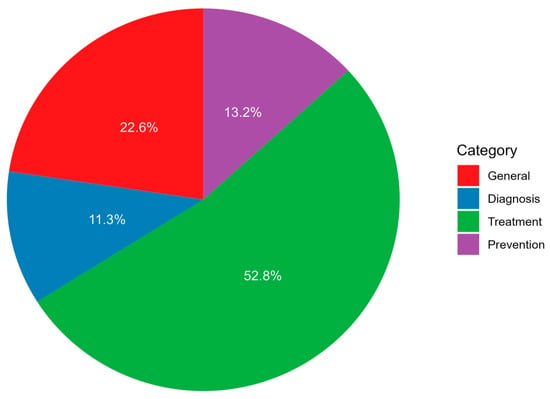
Figure 1
Open AccessComment
Higher Mortality Rates in Testicular Cancers in Low-Middle Income Countries—Is It True for All Low-Middle Income Countries? Comment on Majdalany et al. Challenges of Urologic Oncology in Low-to-Middle-Income Countries. Soc. Int. Urol. J. 2024, 5, 303–311
by
Lekha Madhavan Nair and Francis Vadakkumparambil James
Soc. Int. Urol. J. 2025, 6(2), 33; https://doi.org/10.3390/siuj6020033 - 18 Apr 2025
Abstract
We read the review entitled ‘Challenges of Urologic Oncology in Low-to-Middle Income Countries’ by Majdalany et al [...]
Full article
Open AccessArticle
The Impact of MISTs on Australian BPO Surgical Trends
by
David Armany, Lequang Vo, Kathleen Lockhart, Tania Hossack, David Ende, Simon Bariol, Sriskanthan Baskaranathan and Henry Woo
Soc. Int. Urol. J. 2025, 6(2), 32; https://doi.org/10.3390/siuj6020032 - 17 Apr 2025
Abstract
►▼
Show Figures
Background/Objectives: To evaluate the impact of Minimally Invasive Surgical Therapies (MISTs) on Australian trends for surgeries treating lower urinary tract symptoms (LUTSs) caused by benign prostatic obstruction (BPO). The recent adoption of the prostatic urethral lift (PUL) and water vapour thermal therapy
[...] Read more.
Background/Objectives: To evaluate the impact of Minimally Invasive Surgical Therapies (MISTs) on Australian trends for surgeries treating lower urinary tract symptoms (LUTSs) caused by benign prostatic obstruction (BPO). The recent adoption of the prostatic urethral lift (PUL) and water vapour thermal therapy (such as Rezum) into the Medicare Benefits Scheme (MBS) item schedule on the 1 March 2024 has likely had an impact on Australian surgical trends and we aim to describe their impact on the use of other commonly offered BPO-related surgeries. Methods: This study analyses population-adjusted rates of BPO-related surgeries in Australia from January 2004 to September 2024 using publicly available online Medicare Statistics and Census Data. Independent t-tests and significance levels were calculated to compare procedure rates before and after the introduction of PUL and Rezum in March 2024. Results: In total, 301,648 BPO surgical procedures were claimed under MBS in Australia from January 2004 to September 2024, with transurethral resection of the prostate (TURP) being the most common (78%). Procedure rates increased overall with significant shifts in treatment preference: TURP rates have steadily declined in Australia after peaking in 2009 (123.4 per 100,000 adult men), whilst photo-selective vaporisation of the prostate (PVP) and enucleation have risen. Following the introduction of PUL and Rezum on 1 March 2024, enucleation and simple prostatectomy rates increased, while Transurethral needle ablation (TUNA) and urethral and prostatic prosthesis (UPP) decreased. TURP rates were unaffected. Conclusions: Throughout the past two decades, BPO surgical trends in Australia have shifted, with TURP declining as PVP and enucleation have risen. The 2024 MBS listing for PUL and Rezum has boosted their uptake whilst reducing both TUNA and UPP claims. Simple prostatectomy rates remained stable.
Full article
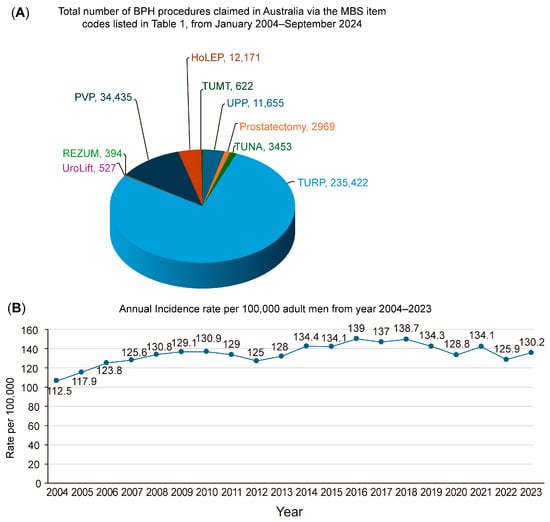
Figure 1
Open AccessArticle
Epidemiological Insights into Erectile Dysfunction in the United States: A Google Trends Analysis
by
Zaid Ahmed, Muhammed A. Moukhtar Hammad, Jake Miller, Elia Abou Chawareb, Lawrence C. Jenkins and Faysal A. Yafi
Soc. Int. Urol. J. 2025, 6(2), 31; https://doi.org/10.3390/siuj6020031 - 17 Apr 2025
Abstract
►▼
Show Figures
Background/Objectives: Erectile dysfunction (ED) significantly impacts the well-being and quality of life of millions of men. Understanding geographic patterns and associated factors influencing ED search trends can offer valuable insights for healthcare improvement and advocacy. This study investigated the correlation between Google search
[...] Read more.
Background/Objectives: Erectile dysfunction (ED) significantly impacts the well-being and quality of life of millions of men. Understanding geographic patterns and associated factors influencing ED search trends can offer valuable insights for healthcare improvement and advocacy. This study investigated the correlation between Google search trends for ED and various factors across the US. Methods: Google search trends for “erectile dysfunction” were collected over a 6-year period between March 2018 and August 2024. The Google search trends provided data for individual states on a scale from 1 to 100. Search volumes were analyzed alongside the urologist-to-population ratio, percentage of the population aged 65 and older, median household income, and percentage of state residents with a bachelor’s degree or higher. Pearson correlation coefficients were used to examine the relationships between ED search volumes and these factors. Results: Higher ED search volumes were associated with a higher percentage of older adults (r = 0.4332, p = 0.001676). A negative correlation was found between ED search volume and higher education (r = −0.482, p = 0.000394). No significant correlation was found between median household income and ED search volume (r = −0.201, p = 0.164) or a greater urologist density (r = 0.0612, p = 0.6729). Conclusions: This study highlights how healthcare access and demographics influence ED search trends. States with older, less educated populations showed higher interest, while wealthier areas with more urologists had no significant correlation. These findings can guide targeted interventions to improve sexual care in underserved regions.
Full article
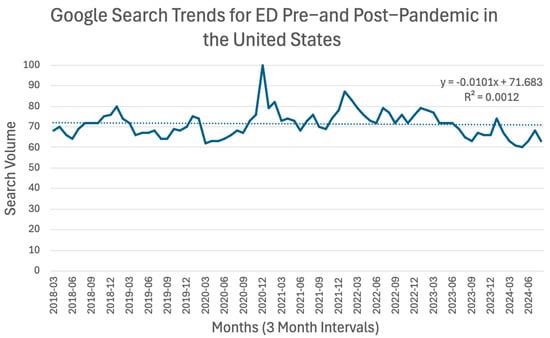
Figure 1
Open AccessArticle
Gender Disparity in Arabian Gulf Urological Conferences Over the Past Three Years
by
Mohammed Zain Ulabedin Adhoni, Ahmed Nassar and Mohammed Shahait
Soc. Int. Urol. J. 2025, 6(2), 30; https://doi.org/10.3390/siuj6020030 - 17 Apr 2025
Abstract
Background/Objectives: Gender disparity is prevalent in urology and other surgical specialties, with under-representation of females in both academic and professional settings, including in the Arabian Gulf region. To investigate female participation in Arabian Gulf urological conferences over the past three years, focusing on
[...] Read more.
Background/Objectives: Gender disparity is prevalent in urology and other surgical specialties, with under-representation of females in both academic and professional settings, including in the Arabian Gulf region. To investigate female participation in Arabian Gulf urological conferences over the past three years, focusing on abstract presenters, faculty, speakers, and moderators. Methods: Data were collected from three major conferences: the 34th Saudi Urological Conference (SUA), the Urological Asian Association and Emirates Urological Conference (UAA-EUSC), and the 11th Emirates Urological Conference and 18th Pan Arab Continence Society Conference (EUSC-PACSC). The gender of the presenters and faculty was identified using genderize.io, faculty images, and Google searches. Statistical analyses, including chi-square and Fisher’s exact tests, were conducted to assess gender disparities. Results: Out of 536 abstracts, 13.25% were presented by females, with significant variation across conferences (p = 0.018). Female representation was lowest in the basic sciences category (3.13%) and highest in the other category (35.29%) (p = 0.01). Abstract to publication rates did not differ significantly between genders. Male dominance was noted among faculty members (94.21% male), speakers (96.44% male), and moderators (98.98% male), with no significant gender distribution differences across roles (p = 0.1762). Conclusions: This study highlights significant gender disparities at Arabian Gulf urological conferences, particularly in leadership roles and research presentations. Recommendations include promoting female leadership, supporting mentorship programs, and ensuring gender diversity in conference management and speaker line-ups to foster a more inclusive environment.
Full article
Open AccessSystematic Review
The Role of Magnetic Resonance Imaging in Penile Fracture Management—A Systematic Review
by
Henry Wang, Shravankrishna Ananthapadmanabhan, Jeremy Saad, Alexander Combes, Jarrah Spencer, Sunny Nalavenkata and Ankur Dhar
Soc. Int. Urol. J. 2025, 6(2), 29; https://doi.org/10.3390/siuj6020029 - 17 Apr 2025
Abstract
►▼
Show Figures
Background/Objectives: Penile fractures are a rare urological emergency, defined as the traumatic rupture of the tunica albuginea. They are classically diagnosed on clinical grounds, requiring urgent operative repair, most commonly by penile degloving. Magnetic resonance imaging (MRI) has emerged as a promising tool
[...] Read more.
Background/Objectives: Penile fractures are a rare urological emergency, defined as the traumatic rupture of the tunica albuginea. They are classically diagnosed on clinical grounds, requiring urgent operative repair, most commonly by penile degloving. Magnetic resonance imaging (MRI) has emerged as a promising tool in the management of penile fractures. Often recommended in the setting of equivocal clinical diagnoses, MRI can help diagnose, as well as localise, the site of injury. Furthermore, it also holds potential in differentiating penile fractures from mimicking conditions, thereby possibly preventing unnecessary surgical procedures. This study is aimed at evaluating the diagnostic accuracy of MRI for penile fractures. Furthermore, it seeks to explore MRI’s effectiveness in guiding the surgical approach through precise localisation of the injury site. Methods: The PubMed, Embase, and Cochrane databases were searched from January 1995 to December 2022. The Preferred Reporting Items for Systematic Reviews and Meta-Analyses (PRISMA) guidelines were followed, and a total of 246 cases from 32 studies were identified. Results: Pooled results for MRI use in penile fracture diagnosis resulted in a positive predictive value of 97.8%, a negative predictive value of 87.0%, a sensitivity of 98.6%, and a specificity of 80%. MRI can accurately guide localised incisions, due to its ability to accurately identify the exact site of injury, with no additional reported complications or conversions to degloving. Considerable heterogeneity was observed within MRI parameters and protocols used in the studies identified. Conclusions: This review suggests that MRI is an accurate imaging modality for penile fractures and should be considered as a first-line investigation for equivocal cases. Its application may refine clinical management by avoiding unnecessary surgeries in cases mimicking penile fractures and improve pre-operative planning through precise injury localisation. This study is limited by heterogeneity in MRI protocols and the small sample sizes and retrospective nature of many included studies. The future standardisation of MRI protocols could enhance its utility and reliability in the clinical setting. Additionally, further research is needed to evaluate the long-term outcomes following the repair of small fractures detected on MRI and following MRI-guided localised incisions during surgical repair. Level of Evidence: 2.
Full article
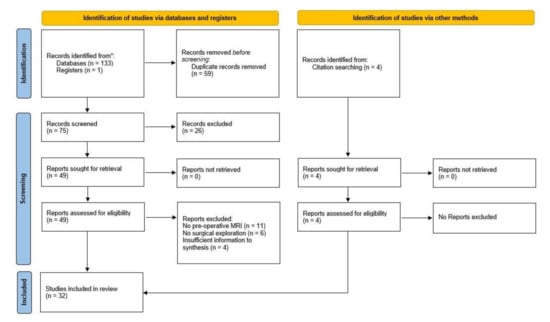
Figure 1
Open AccessSystematic Review
Features and Management of Incidental Prostatic Lymphoma Obtained in Lower Urinary Tract Symptoms Surgery: A Systematic Review
by
Jeremy Cheng, Samith Minu Alwis, Nathan Papa, Joseph Ischia, Damien Bolton and Dixon Woon
Soc. Int. Urol. J. 2025, 6(2), 28; https://doi.org/10.3390/siuj6020028 - 17 Apr 2025
Abstract
►▼
Show Figures
Background/Objectives: Prostatic lymphoma is a rare malignant tumour that frequently causes urinary tract obstruction. It is uncommon for patients to present with systemic features or B-symptoms. As a result, it is often diagnosed incidentally during surgical lower urinary tract symptoms (LUTS) treatment.
[...] Read more.
Background/Objectives: Prostatic lymphoma is a rare malignant tumour that frequently causes urinary tract obstruction. It is uncommon for patients to present with systemic features or B-symptoms. As a result, it is often diagnosed incidentally during surgical lower urinary tract symptoms (LUTS) treatment. This systematic review aims to identify any common clinical features of prostatic lymphoma diagnosed incidentally during surgical LUTS treatment and summarise disease treatment and outcomes. Methods: The study protocol was registered with Prospective Register of Systematic Reviews (PROSPERO). A search was performed across the following electronic databases: MEDLINE, Embase, Web of Science, and Cochrane Database of Systematic Reviews. Full texts of eligible studies were analysed and data were extracted. The review was performed in accordance with PRISMA guidelines. Results: A total of 24 case reports compromising 25 cases were included. The median (IQR) age was 67 (61–73) years. All patients reported LUTS as their primary complaint, and the median duration of LUTS prior to diagnosis was 17 (4–44) months. Serum prostate-specific antigen (PSA) was normal in 10 cases and prostatomegaly present on imaging in 16 cases. A total of 10 different subtypes of lymphoma were reported. Extra-prostatic involvement was reported in eight patients. Chemotherapy, with or without adjuvant radiotherapy, was the mainstay of lymphoma treatment. The majority of articles reported positive outcomes, with complete remission in 17 cases. Conclusions: Prostatic lymphoma is a difficult clinical diagnosis due to its similar presentation to benign prostatic hyperplasia (BPH). Although rare, prostatic lymphoma may need to be considered as a diagnosis in patients with an atypical presentation of BPH. Prognosis is often favourable after prompt referral to haematology or oncology.
Full article
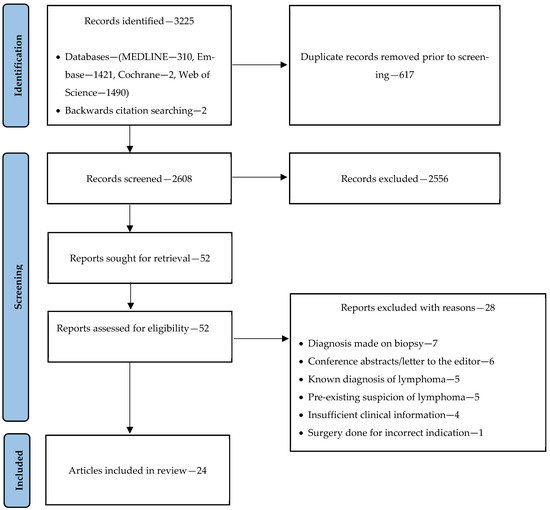
Figure 1
Open AccessArticle
Is YouTube a Reliable Source of Information for Sacral Neuromodulation in Lower Urinary Tract Dysfunction?
by
Sarah Lorger, Victor Yu and Sithum Munasinghe
Soc. Int. Urol. J. 2025, 6(2), 27; https://doi.org/10.3390/siuj6020027 - 17 Apr 2025
Abstract
Background/Objectives: YouTube is an open-access video streaming platform with minimal regulation which has led to a vast library of unregulated medical videos. This study assesses the quality of information, understandability and actionability of videos on YouTube pertaining to sacral neuromodulation (SNM). Methods
[...] Read more.
Background/Objectives: YouTube is an open-access video streaming platform with minimal regulation which has led to a vast library of unregulated medical videos. This study assesses the quality of information, understandability and actionability of videos on YouTube pertaining to sacral neuromodulation (SNM). Methods: The first 50 videos on YouTube after searching “sacral neuromodulation for bladder dysfunction” were reviewed. Thirty-eight of these videos met the inclusion criteria. These videos were reviewed by two Urology Registrars and the videos were scored using two standardised tools. The DISCERN tool assesses quality of information and the Patient Education Materials Assessment Tool for Audiovisual Material (PEMAT-A/V) tool assesses user understandability and accessibility. Results: Forty-two percent of videos were deemed to be poor or very poor, with 58% being fair, good or excellent according to the DISCERN standardised tool. For PEMAT-A/V the average score for understandability was 74% (43–100%) and actionability was 38% (0–100%). We found statistical significance comparing the duration of videos to the DISCERN groups (p = 0.02). We also found significance comparing the understandability of videos using the PEMAT-A/V score to the DISCERN groups (p ≤ 0.05). Conclusions: Forty-two percent of videos on SNM are of poor or very poor quality. The actionability score for consumers to seek out further information is also low at 38%. This raises concerns about the quality of information that is widely available on YouTube and how consumers will use this information when making decisions about their health.
Full article
Open AccessSystematic Review
Xanthogranulomatous Prostatitis: A Systematic Review
by
Kenneth Keen Yip Chew, Gerald Chin Ho Mak and Eddy Lee Hao Wong
Soc. Int. Urol. J. 2025, 6(2), 26; https://doi.org/10.3390/siuj6020026 - 16 Apr 2025
Abstract
►▼
Show Figures
Background/Objectives: To understand the clinical characteristics, risk factors, diagnosis, treatment, and outcomes of xanthogranulomatous prostatitis. Methods: A comprehensive search was conducted across PubMed, Embase, and Medline following Preferred Reporting Items for Systematic Reviews and Meta-analyses (PRISMA) guidelines, including case reports and case series.
[...] Read more.
Background/Objectives: To understand the clinical characteristics, risk factors, diagnosis, treatment, and outcomes of xanthogranulomatous prostatitis. Methods: A comprehensive search was conducted across PubMed, Embase, and Medline following Preferred Reporting Items for Systematic Reviews and Meta-analyses (PRISMA) guidelines, including case reports and case series. Study quality and risk of bias were assessed using the Oxford Centre for Evidence-Based Medicine (CEBM) document. The systematic review process aimed to gather and synthesize all available research evidence on the topic. Results: We included 24 articles reporting on 33 patients, with a median age of 64 years. The most common presenting symptoms were lower urinary tract symptoms (81.8%), and only one patient was asymptomatic. The mean prostate-specific antigen (PSA) level upon presentation was 6.5 ng/mL. Notably, 51.5% of patients were suspected of harbouring clinically significant prostate carcinoma, and only one patient had concurrent prostate adenocarcinoma. All diagnoses were based on changes associated with xanthogranulomatous prostatitis demonstrated upon histopathological examination. A variety of pathogens were isolated, including Escherichia coli, Pseudomonas aeruginosa, Proteus species, and Enterobacter species. Transurethral resection of the prostate (60.6%) was the mainstay approach to management. In total, 27.3% of patients were successfully managed with non-surgical therapy. Conclusions: The majority of patients were suspected of prostate carcinoma prior to the histopathological diagnosis of xanthogranulomatous prostatitis. One patient underwent unnecessary radical prostatectomy as a result. The management of xanthogranulomatous prostatitis includes transurethral resection of the prostate and conservative management with the use of antibiotics. This outlines the importance of following well-established protocols upon suspicion of prostate carcinoma in order to avoid unnecessary radical prostatectomy.
Full article
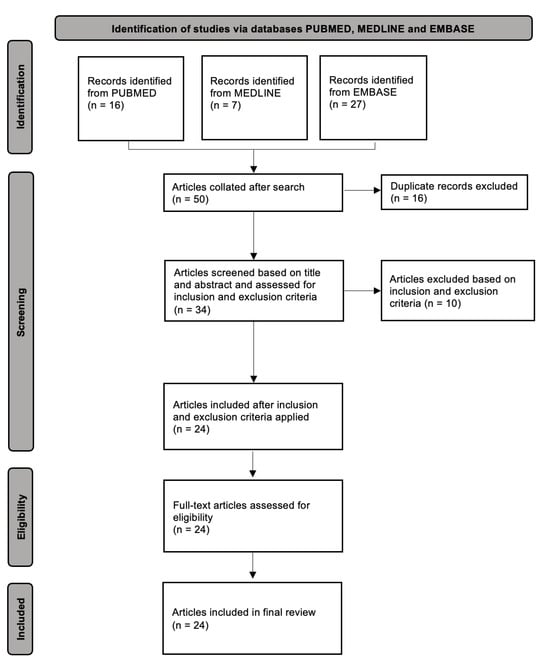
Figure 1
Open AccessGiants in Urology
Donald G. Skinner
by
Eila C. Skinner
Soc. Int. Urol. J. 2025, 6(2), 25; https://doi.org/10.3390/siuj6020025 - 16 Apr 2025
Abstract
I was very pleased to have the opportunity to write a short piece about Dr. Donald Skinner, a true giant in urology [...]
Full article
Open AccessInteresting Images
Duplicated Kidney: A New Variant
by
Deepak Sabharwal, Sahil Sabharwal and Sarat Sabharwal
Soc. Int. Urol. J. 2025, 6(2), 24; https://doi.org/10.3390/siuj6020024 - 16 Apr 2025
Abstract
►▼
Show Figures
Congenital urinary tract anomalies, including CAKUT (congenital anomalies of the kidneys and urinary tract), are common defects disrupting urinary system development [...]
Full article
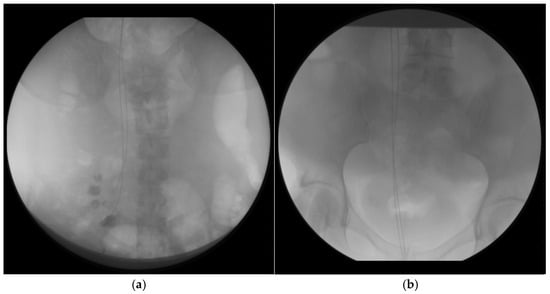
Figure 1
Open AccessEditorial
Approach to Pelvic Organ Prolapse: A Urological Perspective
by
Lysanne Campeau
Soc. Int. Urol. J. 2025, 6(1), 23; https://doi.org/10.3390/siuj6010023 - 19 Feb 2025
Abstract
Pelvic organ prolapse (POP) has an estimated global prevalence of 28 [...]
Full article
Open AccessCommunication
Mapping the Shifting Landscape of Urological Innovation
by
Samuel Sii, David Homewood, Brendan Dittmer, Kalonji Nzembela, Mahesha Weerakoon, Jonathan S. O’Brien, Damien Bolton, Nathan Lawrentschuk, Niall M. Corcoran and Dinesh K. Agarwal
Soc. Int. Urol. J. 2025, 6(1), 22; https://doi.org/10.3390/siuj6010022 - 19 Feb 2025
Abstract
►▼
Show Figures
Introduction: Surgical innovation in urology has significantly transformed clinical practice, balancing the need for dissemination of novel techniques with rigorous safety and efficacy standards. Surgical innovation is influenced by regulatory standards, cost-effectiveness, and evolving publication requirements. This study examines publication trends in pioneering
[...] Read more.
Introduction: Surgical innovation in urology has significantly transformed clinical practice, balancing the need for dissemination of novel techniques with rigorous safety and efficacy standards. Surgical innovation is influenced by regulatory standards, cost-effectiveness, and evolving publication requirements. This study examines publication trends in pioneering urological procedures and their implications on surgical innovation. Methods: This study analyzed 68 pioneering urological publications, examining the relationship between case numbers and publication trends over time. Data were collected through comprehensive database searches and analyzed using linear regression to identify correlations between publication case numbers and innovation dissemination. Results: A significant increase in the number of cases per publication was observed over time (R2 = 0.798, OR = 6.29, 95% CI: 2.57–10.02, p = 0.007). Early transformative techniques were frequently published as single-case reports or small series, whereas incremental innovations required larger case volumes, potentially delaying publication from resource-limited settings. Conclusions: This study highlights the need for a merit-based approach to evaluating surgical innovations, balancing rigorous safety standards with timely dissemination. Frameworks like IDEAL offer structured pathways for evaluating surgical innovations, ensuring robust evidence generation while maintaining flexibility for diverse practice settings. This study advocates for a reassessment of publication criteria to foster a balance between innovation, safety, and inclusivity, ultimately promoting the efficient and equitable advancement of surgical techniques.
Full article

Figure 1

Journal Menu
► ▼ Journal MenuJournal Browser
► ▼ Journal Browser-
arrow_forward_ios
Forthcoming issue
arrow_forward_ios Current issue - Volumes not published by MDPI
Highly Accessed Articles
Latest Books
E-Mail Alert
News
Topics






